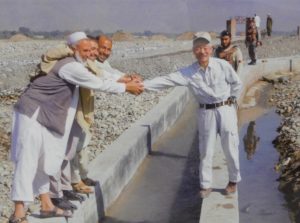“The Third Wave”:a New Trend in Assistance for Developing Countries
picture:A temple in Bali, Indonesia ©The International Development Journal Co., Ltd.
IDJ ENGLISH
Compass “The Third Wave”:a New Trend in Assistance for Developing Countries – Training for foreign workers coming to Japan becomes more important
New Arguments on ODA
As well known, Japan’s population continues to decline. The impact is not limited to labor shortages at construction sites, but has spread to small and medium-sized businesses, as well as the agricultural and social welfare fields throughout the country.
According to the government, the number of SMEs that have to be closed or close has been on the rise, reaching 46,724 in 2018. If this situation continues, SMEs will not survive and employment and technology may be lost. There are concerns about the future. Some estimates suggest that if a large number of SMEs are forced out of business, their gross domestic product (GDP) will decrease by 22 trillion yen.
According to Sankei Shimbun dated January 25, 2020 a general contractor, Kajima Corporation, provides safety training to 100 Myanmar workers every year who work for partner companies that undertake construction work before visiting Japan.
On the other hand, according to Kazuhiko Koshikawa, vice-president of the Japan International Cooperation Agency (JICA), which supports the overseas expansion of SMEs, mainly in rural areas, local communities are also suffering from a shortage of human resources to support overseas business. It is said that some companies are thinking of nurturing people in their destinations and bringing them to Japan to act as business promoters. Japan has entered a period of trial and error in terms of securing human resources.
As well known, Japanese 2nd generation immigrants living in Brazil and Peru in Latin America have come to Japan with their families and are increasing their presence as important workforces throughout Japan. However, most of them have difficulties in terms of language problems and lifestyle habits. Therefore, there is a proposal to send former members of Japan Overseas Cooperation Volunteers (JOCV), who have a local sense of developing countries, to play a role in mediating between Japanese Latin Americans and Japanese society.
However, some people say that ODA-based domestic assistance to human resources (workers) in developing countries coming to Japan is “not ODA”. In contrast, the ultimate goal of ODA is to increase the income of the people of developing countries to lift them from poverty. So there are argumentation that the way to directly generate income for the people of developing countries is truly by aid.
Turning now to look at the United States, the money remittance to mother countries by developing countries’ people working in the US is highly valued as direct aid.
Huge weight of remittance from the US to Latin America
Around 2004, the magazine “Foreign Affairs” reported that salary repatriation from developing countries’ workers in the US reached a total of $ 18 billion in 2000. However, the “Financial Times” calls this a labor force export from developing countries that supplies “new fuel for development”. “Newsweek” in January, 2004, issued feature stories named the “Migration Economy” focusing on migrant labor forces and their remittances.
In other words, Americans say, “There is no other assured way to reach poor families in poor countries than remittances from the US. Their direct effect is higher than governmental ODA.” Looking at the scale of remittances from the US to developing countries at the year 2004-05 level, it has doubled from about $ 21 billion to $ 50 billion over the past ten years.
The breakdown is Latin America $ 14.5 billion, India $ 11.5 billion, Middle East $ 10.4 billion and Eastern Europe $ 6.2 billion. For example, remittances from the US to six Latin American countries accounted for more than 10% of these countries’ GDP.
The US considers remittances from the US to be the “third wave,” as it is the third aid after (1) ODA and (2) private investment and loans to developing countries.
In Southeast Asia, migrant workers from the Philippines to the US are prominent for historical reasons. Among them, the migration of nurses to the US is widely known.
“If a Filipino working abroad increases repatriation by $ 20 per person per month, GDP increases 2%, $1.68 billion a year,” said former Philippine President Gloria Arroyo, who visited California in November 2004. At the time, the Philippines’ migrant population was estimated to be over 7 million, so the remittance was said to be equivalent to 1% of GDP. Now their migrant population abroad may be in the vicinity of 10 million.
Expected role of JICA
In the US, NPOs, corporate philanthropy, universities, religious organizations, and personal donations, are said to be more than 3.5 times the ODA annual budget. Even now, the repatriation of those working in the US is highly valued as a worthy aid record.
Japan’s aid to developing countries is not just limited to ODA and private investment. However, it is also time for people in developing countries to earn money in Japan and repatriate to mother countries in a broader sense. This could be counted as “government aid” or as “direct aid to poor countries”. It can also be an aid concept of Sustainable Development Goals (SDGs).
In response to such new situations, JICA and other ODA agencies should consider ways to help local people improve their skills and knowledge making use of overseas offices and “Japan Centers” in various parts of Asia.
Contributing to the improvement of the quality of workers in developing countries coming to Japan, their remittances from Japan to their home countries should be taken into account as a direct concept of “development country assistance”.
Developing country workers who have acquired new knowledge and skills in Japan may return home to contribute to their own development, or come back to Japan to further enhance their abilities. In this way, Japan will gradually integrate with Asia as the population declines, and eventually Japan will move to an era where it is necessary to live in such a wave of citizens’ exchanges with Asia.
By Mitsuya Araki, Editor-in-chief of IDJ
*****以下、日本語原文*****
羅針盤 途上国援助に“第3の波” 来日する途上国労働者の研修
新たなODA論争
周知のように、日本の人口減少は止まらない。その影響は建設現場での人手不足にとどまらず、全国各地の中小企業をはじめ農業分野、社会福祉分野にまで広がっている。
政府によると、中小企業の休廃業・解散件数は増加傾向にあって2018年は4万6,724件に達し、このままでは中小企業の廃業に歯止めがかからず、地域における雇用や技術が失われる恐れがあると将来への懸念を示している。もし大量の中小企業が廃業に追い込まれると、国内総生産(GDP)の22兆円が減少するという試算もある。
産経新聞(1月25日付)によると、ゼネコン大手の鹿島建設(株)は同社の工事を請け負う協力会社に就職するミャンマー人に対して、来日前に現地で安全教育などを施し、毎年100人規模を協力会社に派遣する方針を明らかにしている。
他方、地方を中心に全国レベルで中小企業の海外展開を支援している国際協力機構(JICA)副理事長、越川和彦氏によると、地方でも海外事業を支える人材不足に悩まされており、なかには進出した先で人を育てて、彼らを日本に連れて来て事業の推進役になってもらうと考えている企業も現れているという。日本は人材確保という点で、まさに試行錯誤の時代を迎えている。
周知のように、中南米のブラジルやペルーから日系人が家族ともども来日して、日本各地で重要な労働力として存在感を高めている。ところが、多くは言葉の問題は言うまでもなく、生活習慣の面でも不自由な生活を強いられているという。そこで、途上国の現地感覚を身につけたJICAの青年海外協力隊OBを派遣して、日系人と日本社会との仲を取り持つ役割を果たしてもらおうという提案もある。
ところが、来日する途上国人材(労働者)への政府開発援助(ODA)ベースの国内支援は「ODAではない」と待ったをかける意見も聞かれる。これに対して、途上国援助(ODA)の最終目的は、その国の人びとの所得を増やし、貧国からの脱出を目指すことであるから、途上国の人びとにとって直接収入となる所得こそ真の援助ではないのか、との反論も聞こえてくる。
そこで目を海外に転じると、米国では途上国の人びとが本国に送金するお金こそ、直接的な援助として高く評価されている。次は少し古い話だが、筆者が2005年頃に取材した米国での同じケースの話を述べてみたい。
ODA第3の波
2004年頃、有名な『フォーリン・アフェアーズ』誌は、米国で働く途上国労働者からの本国送金は、2000年レベルで総額180億ドルに達していると報告していた。だが、『フィナンシャル・タイムズ』はこれを“開発に新たな燃料”を供給する途上国からの労働力輸出だと言い、2004年1月号の『ニューズウィーク』は“Migration Economy”と題する移民労働者の送金問題を特集していた。
つまり、米国人に言わせると、「米国からの送金ほど確実に貧しい途上国の家庭に届くお金はない。その直接的効果は政府の対外援助(ODA)より高い」である。そこで、どのくらいの規模で米国から途上国へ送金しているかを2004~05年レベルで展望すると、その時点から過去10年を振り返ると約210億ドルから500億ドルへと倍増している。その内訳を見ると、中南米145億ドル、インド115億ドル、中東104億ドル、東欧62億ドルである。例えば、中南米6カ国が受け取った米国からの送金は、中南米各国のGDP(国内総生産)の10%以上を占めていた。
米国では米国からの送金を、(1)政府開発援助(ODA)、(2)途上国への民間投融資に続く第3の援助と考えて、これを“第3の波”と呼んでいる。
東南アジアでは歴史的な関係からフィリピンの米国への出稼ぎが目立っている。なかでも看護師の米国への出稼ぎは広く知られている。2004年11月にカリフォルニア州を訪れたフィリピンのグロリア・マカパガル・アロヨ大統領(当時)は、「海外で働くフィリピン人が本国送金を1人当たり月額20ドル増やしたら、GDP(国内総生産)の2%に相当し、年間16億8,000万ドルが受け取れる」と述べている。当時のフィリピンの海外出稼ぎ人口は700万人超と見られていたので、送金額はGDP1%に相当すると言われていた。今では恐らく海外出稼ぎ人口は1,000万人レベルではないだろうか。
期待されるJICAの役割
米国では、ODAよりも“第3の波”と言われるNPO、企業の慈善活動、大学、宗教団体、個人献金などが注目され、そのスケールはODA年間予算の3.5倍以上だとみられている。今でも米国で働く人たちの本国送金を立派な援助実績として高く評価している。
日本の途上国援助もODAや民間投資のみならず、途上国の人たちが日本で稼いで本国送金することも、広い意味で日本の援助の範囲に入れてもよい時代を迎えていると言えないだろうか。これは“政府援助”にカウントされてもよい、“直接的貧国援助”としてカウントされてもよいものであろう。また、国際的に認知されている持続可能な開発目標(SDGs)にも堂々と入る援助概念であると言える。
こうした新しい局面に対して、かつての職業訓練学校に代わってJICAなどODA実施機関は得意とする研修ノウハウを生かし、海外事務所やアジア各地の「日本センター」を含めて途上国からの出稼ぎ労働者の技術や知識の向上を現地でも助ける方策を検討すべきである。
来日する途上国労働者の質的向上に寄与し、日本から母国への彼らの送金も大きくとらえて直接的な「途上国援助」という概念に含めるべきであろう。
日本で新しい知識や技術を身につけた途上国労働者は、いずれ帰国して自国の発展に寄与したり、あるいは、再度来日して更に能力を高めていく可能性も考えられる。こうして、日本は人口減少が進む中で少しずつアジアとの一体化が進み、いずれ日本はそうした大きなアジアとの国民・市民交流のうねりの中で生きていかなければならない時代へ移行していくことになろう。
国際開発ジャーナル主幹 荒木光弥
『国際開発ジャーナル』2020年3月号掲載記事




